�
CCIE Professional Development: Routing TCP/IP, Volume I
Copyright Information
Copyright© 1998 by Macmillan Technical Publishing
Cisco Press logo is a trademark of Cisco Systems, Inc.
All rights reserved. No part of this book m ay be reproduced or transm itted in any form
or by any means, electronic or mechanical, including photocopying, recording, or by
any information storage and retrieval system, without written permission from the
publisher, except for the inclusion of brief quotations in a review.
Printed in the United States of America 2 3 4 5 6 7 8 9 0
Library of Congress Cataloging- in- Publication Number 98- 84220
Warning and Disclaimer
This book is designed to provide information about TCP/IP. Every effort has been
made to make this book as complete and as accurate as possible, but no warranty or
fitness is implied.
The information is provided on an "as is" basis. The author, Macmillan Technical
Publishing, and Cisco Systems, Inc. shall have neither liability nor responsibility to any
person or entity with respect to any loss or damages arising from the information
contained in this book or from the use of the discs or programs that may accompany
it.
The opinions expressed in this book belong to the author and are not necessarily
those of Cisco Systems, Inc.
Dedications
This book would not have been possible without the concerted efforts of many
dedicated people. I would like to thank the following people for their contributions:
First, thanks to Laurie McGuire, development editor, who not only improved the book
but improved me as a writer.
Thanks to Jenny DeHaven Carroll and Mike Tibodeau for their careful technical editing.
I would also like to thank the following people, who provided technical advice or
reviews on selected sections of the book: Howard Berkowitz, Dave Katz, Burjiz
Pithawala, Mikel Ravizza, Russ White, and Man- Kit Yueng.
I would like to thank the following people at Macmillan Technical Publishing: Tracy
Hughes and Lynette Quinn, who managed the project, and Julie Fairweather, the
Executive Editor. In addition to being highly competent, they are three of the nicest
people anyone could hope to work with. Also, thanks to Jim LeValley, Associate
Publisher, who first approached me about writing this book.
Thanks to Wandel & Golterman, and to Gary Archuleta, W&G's Regional Sales
Manager in Denver, for arranging the use of one of their excellent protocol analyzers
for the length of the project.
Finally, I want to thank my wife, Sara, and my children: Anna, Carol, James, and
Katherine. Their patience, encouragement, and support were critical to the completion
of this book.
�
Feedback Information
At Cisco Press, our goal is to create in- depth technical books of the highest quality and value. Each
book is crafted with care and precision, undergoing rigorous development that involves the unique
expertise of members from the professional technical community.
Readers' feedback is a natural continuation of this process. If you have any comments regarding
how we could improve the quality of this book, or otherwise alter it to better suit your needs, you
can contact us at ciscopress@m cp.com . Please make sure to include the book title and ISBN in your
message.
We greatly appreciate your assistance.
Trademark Acknowledgments
All terms mentioned in this book that are known to be trademarks or service marks have been
appropriately capitalized. Macmillan Technical Publishing or Cisco Systems, Inc. cannot attest to the
accuracy of this information. Use of a term in this book should not be regarded as affecting the
validity of any trademark or service mark.
About the Reviewers
Jennifer DeHaven Carroll is a principal consultant for International Network Services. She is CCIE
number 1402. Jennifer has planned, designed and implemented many IP networks over the past 10
years, utilizing RIP version 2, IGRP, E- IGRP, OSPF and BGP. She has also developed and taught
theory and Cisco implementation classes on all IP routing protocols.
Michael Tibodeau is a Systems Engineer for Cisco Systems. Over the past two years, Michael has
specialized in security technologies for both his own customers and Networkers audiences. He also
focuses on the Electronic Com m erce and Quality of Service arenas. Michael holds a Bachelor's
degree in Systems Engineering from the University of Virginia and holds a Master's degree in
Systems Engineering and Management, concentrating on telecommunications.
I nt roduct ion
Routing is an essential element of all but the smallest data communications networks. At one level,
routing and the configuration of routers are quite simple. But as internetworks grow in size and
complexity, routing issues can become at once both large and subtle. Perversely, perhaps, I am
grateful for the difficult problems large- scale routing can present—as a network systems consultant,
these problems are my bread and butter. Without them, the phrase "You want fries with that?" could
be an unfortunate part of my daily vocabulary.
Cisco Certified Internetwork Experts are widely recognized for their ability to design, troubleshoot,
and manage large internetworks. This recognition comes from the fact that you cannot become a
CCIE by attending a few classes and then regurgitating some memorized facts onto a written test. A
CCIE has proven his or her expertise in an intense, famously difficult hands- on lab exam.
Objectives
This book is the first in a series designed to aid you in becoming a Cisco Certified Internetwork
Expert and the first of two volumes that focuses on TCP/IP routing issues. Early in the project, Kim
Lew, Cisco Systems program manager, said, "Our objective is to make CCIEs, not to make people
who can pass the CCIE lab." I entirely agree with that statement and have used it as a guiding
principle throughout the writing of this book. Although the book includes many case studies and
exercises to help you prepare for the CCIE lab, my primary objective is to increase your
understanding of IP routing—both on a generic level and it is implemented on Cisco routers.
Audience
The audience for this book is any network designer, administrator, or engineer who needs a full
understanding of the interior routing protocols of TCP/IP. Although the practical aspects of the book
focus on Cisco's IOS, the information is applicable to any routing platform.
�
The book is not only for readers who plan to become Cisco Certified Internetwork Experts, but for
anyone who wishes to advance his or her knowledge of TCP/IP routing. These readers will fall into
one of three categories:
The "beginner" who has some basic networking knowledge and wishes to begin a deep study
of internetworking
The intermediate- level networking professional who has experience with routers, Cisco or
otherwise, and plans to advance that experience to the expert level
The highly experienced networking expert. This individual has extensive hands- on expertise
with Cisco routers and is ready to take the CCIE lab; however, he or she wants a structured
review and series of exercises for verification and validation.
CCI E Professional Developm ent: Routing TCP/ I P, Volum e I focuses prim arily on the interm ediate-
level networking professional while offering to the beginner a structured outline of fundam ental
inform ation and to the expert the required challenges to hone his or her skills.
Organization
The fourteen chapters of the book are divided into three parts.
Part I examines the basics of networks and routing. Although more advanced readers may wish to
skip the first two chapters, I recommend that they at least skim Chapter 3, "Static Routing," and
Chapter 4, "Dynamic Routing Protocols."
Part II covers the TCP/IP Interior Gateway Protocols. Each protocol- specific chapter begins with a
discussion of the mechanics and parameters of the protocol. This general overview is followed by
case studies on configuring and troubleshooting the protocol on Cisco routers in various network
topologies.
The Exterior Gateway Protocols, as well as such topics as multicast routing, Quality of Service
routing, router security and management, and routing IPv6 will be covered in Volume II.
Part III examines the tools available for creating and managing interoperability with multiple IP
routing protocols, as well as such tools as default routes and route filtering. These chapters, like the
ones in Part II, begin with concepts and conclude with case studies.
Conventions and Features
Most chapters conclude with a set of review questions, configuration exercises, and troubleshooting
exercises. The review questions focus on the theoretical aspects of the chapter topic, whereas the
configuration and troubleshooting exercises address Cisco- specific aspects of the chapter topic.
Also at the end of each chapter is a table with a brief description of all important Cisco IOS
commands used in that chapter. The conventions used to present these commands are the same
conventions used in the IOS Command Reference. The Command Reference describes these
conventions as follows:
Vertical bars (|) separate alternative, mutually exclusive, elements.
Square brackets [] indicate optional elements.
Braces {} indicate a required choice.
Braces within square brackets [{}] indicate a required choice within an optional element.
Boldface indicates commands and keywords that are entered literally as shown.
I talics indicate arguments for which you supply values.
I m portant concepts are called out in m argin notes for quick reference.
Figure I.1 shows the conventions used in the illustrations throughout the book.
�
Figure I.1. Illustration conventions used in this book.
All protocol analyzer displays shown in the book are taken from a Wandel & Goltermann DA- 320
DominoLAN Internetwork Analyzer.
Foreword
In today's world of networking, mission- critical networks are being designed for data, voice, and
video. Due to different traffic patterns and the quality of service required by each type of
inform ation, solid hands- on experience is imperative for managing, designing, and troubleshooting
these networks.
Attaining a strong degree of hands- on experience translates into in- depth understanding of the
concepts, scalability, and deployment issues of today's networks. Such experience also builds the
expertise to analyze traffic patterns and the knowledge of when, where, and how to apply protocol
and bandwidth features to enhance performance.
To help further your hands- on experience, Cisco Press is publishing the CCIE Professional
Development series of books. Books in this series will significantly help your understanding of
protocol concepts, and they provide real- world examples and case studies to strengthen the
theoretical concepts exam ined. I highly recom m end that you use these books as a hands- on
learning tool by duplicating the exam ples and case studies using Cisco products. You can even take
this further by tweaking the configuration parameters to see which changes each network goes
through by using the extensive debugging features provided in each Cisco product.
In the first book of the CCIE Professional Development series, CCI E Professional Developm ent:
Routing TCP/ I P, Volum e I , Jeff Doyle does a fantastic job of building the TCP/IP concepts, from IP
address classes to analyzing protocol metrics. Each chapter contains examples, network topologies
with IP addresses, packet analysis, and Cisco debugging outputs. In my opinion, the best parts are
the case studies, in which Jeff compares different features of the protocol by using more or less the
similar topology. This generates a strong understanding of the protocol concepts and features.
I recommend CCI E Professional Developm ent: Routing TCP/ I P, Volum e I for any networking
certification, and I believe that it also makes an excellent university networking course book.
Imran Qureshi
CCIE Program Manager
�
Part I: Routing Basics
Chapter 1 Basic Concepts: Internetworks, Routers, and Addresses
Chapter 2 TCP/IP Review
Chapter 3 Static Routing
Chapter 4 Dynamic Routing Protocols
�
Chapter 1. Basic Concepts: Internetworks, Routers, and
Addresses
Bicycles with Motors
Data Link Addresses
Repeaters and Bridges
Routers
Network Addresses
Once upon a time, computing power and data storage were centralized. Mainframes were locked away in
climate-controlled, highly secure rooms, watched over by a priesthood of IS administrators. Contact with
a computer was typically accomplished by bringing a stack of Hollerith cards to the priests, who
interceded on our behalf with the Big Kahuna.
The advent of the minicomputer took the computers out of the IS temple of corporations and universities
and brought them to the departmental level. For a mere $100K or two, engineering and accounting and
any other department with a need for data processing could have their own machines.
Following on the heels of the minicomputers were microcomputers, bringing data processing right to the
desktop. Affordability and accessibility dropped from the departmental level to the individual level,
making the phrase personal computer part of everyone's vocabulary.
Desktop computing has evolved at a mind-boggling pace, but it was certainly not an immediate
alternative to centralized, mainframe-based computing. There was a ramping-up period in which both
software and hardware had to be developed to a level where personal computers could be taken seriously.
Bicycles with Motors
One of the difficulties of decentralized computing is that it isolates users from one another and from the
data and applications they may need to use in common. When a file is created, how is it shared with Tom,
Dick, and Harriet down the hall? The early solution to this was the storied SneakerNet: Put the file on
floppy disks and hand carry them to the necessary destinations. But what happens when Tom, Dick, and
Harriet modify their copies of the file? How does one ensure that all information in all versions are
synchronized? What if those three coworkers are on different floors or in different buildings or cities?
What if the file needs to be updated several times a day? What if there are not three coworkers, but 300
people? What if all 300 people occasionally need to print a hard copy of some modification they have
made to the file?
The local-area network, or LAN, is a small step back to centralization. LANs are a means of pooling and
sharing resources. Servers enable everyone to access a common copy of a file or a common database; no
more "walkabouts" with floppies, no more worries about inconsistent information. E-mail furnishes a
compromise between phone calls, which require the presence of the recipient, and physical mail service,
which is called snail mail for a good reason. The sharing of printers and modem pools eliminates the need
for expensive, periodically used services on every desk.
Of course, in their infancy, LANs met with more than a little derision from the mainframe manufacturers.
A commonly heard jibe during the early years was, "A LAN is like a bike with a motor, and we don't
make Mopeds!" What a difference a few years and a few billion dollars would make.
�
NOTE
Data link
Physically, a LAN accomplishes resource pooling among a group of devices by connecting them to a
common, shared medium, or datalink. This medium may be twisted-pair wires (shielded or unshielded),
coaxial cable, optical fiber, infrared light, or whatever. What matters is that all devices attach commonly
to the data link through some sort of network interface.
A shared physical medium is not enough. Rules must govern how the data link is shared. As in any
community, a set of rules is necessary to keep life orderly, to ensure that all parties behave themselves,
and to guarantee that everyone gets a fair share of the available resources. For a local-area network, this
set of rules, or protocol, is generally called a Media Access Control (MAC). The MAC, as the name
implies, dictates how each machine will access and share a given medium.
So far, a LAN has been defined as being a community of devices such as PCs, printers, and servers
coexisting on a common communications medium and following a common protocol that regulates how
they access the medium. But there is one last requirement: As in any community, each individual must be
uniquely identifiable.
Data Link Addresses
In a certain community in Colorado, two individuals are named Jeff Doyle. One Jeff Doyle frequently
receives telephone calls for the person with whom he shares a name—so much so that his clever wife has
posted the correct number next to the phone to redirect errant callers to their desired destination. In other
words, because two individuals cannot be uniquely identified, data is occasionally delivered incorrectly
and a process must be implemented to correct the error.
Among family, friends, and associates, a given name is usually sufficient for accurately distinguishing
individuals. However, as this example shows, most names become inaccurate over a larger population. A
more unique identifier, such as a United States Social Security number, is needed to distinguish one
person from every other.
NOTE
Frame
Devices on a LAN must also be uniquely and individually identified or they, like humans sharing the
same name, will receive data not intended for them. When data is to be delivered on aLAN , it is
encapsulated within an entity called a frame, a kind of binary envelope. Think of data encapsulation as
being the digital equivalent of placing a letter inside an envelope, as in Figure 1.1[1] . A destination address
and a return (source) address are written on the outside of the envelope. Without a destination address, the
postal service would have no idea where to deliver the letter. Likewise, when a frame is placed on a data
link, all devices attached to the link "see" the frame; therefore, some mechanism must indicate which
device should pick up the frame and read the enclosed data.
[1] As will be seen later, creating a data link layer frame is really more like putting an envelope inside a larger envelope.
�
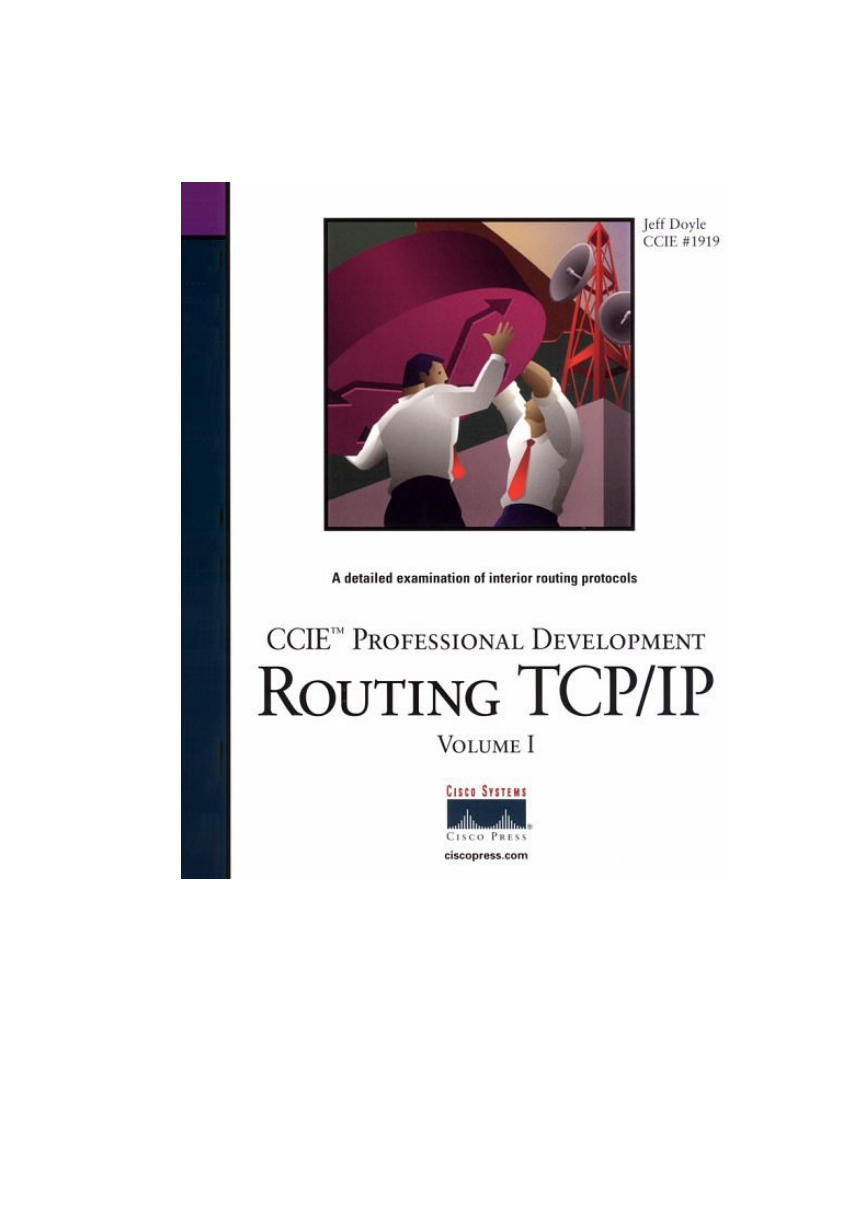
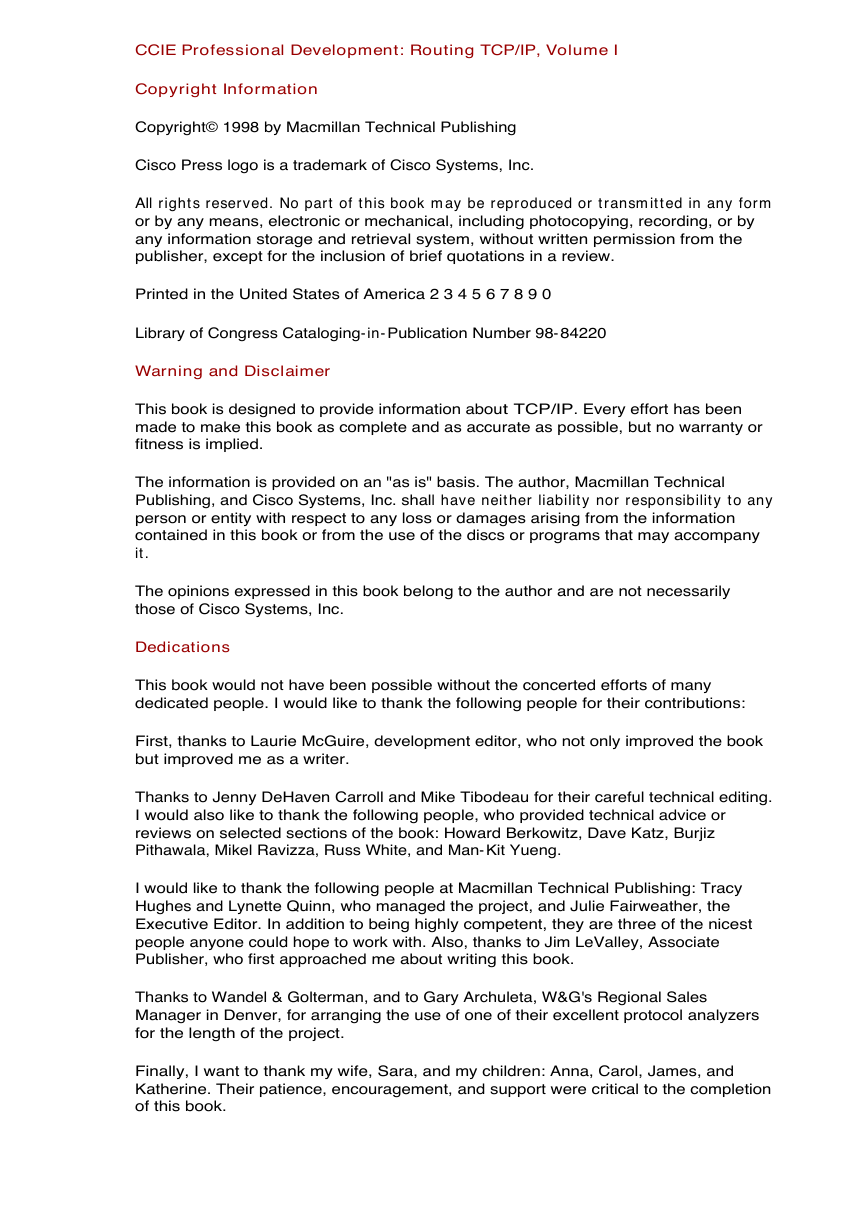
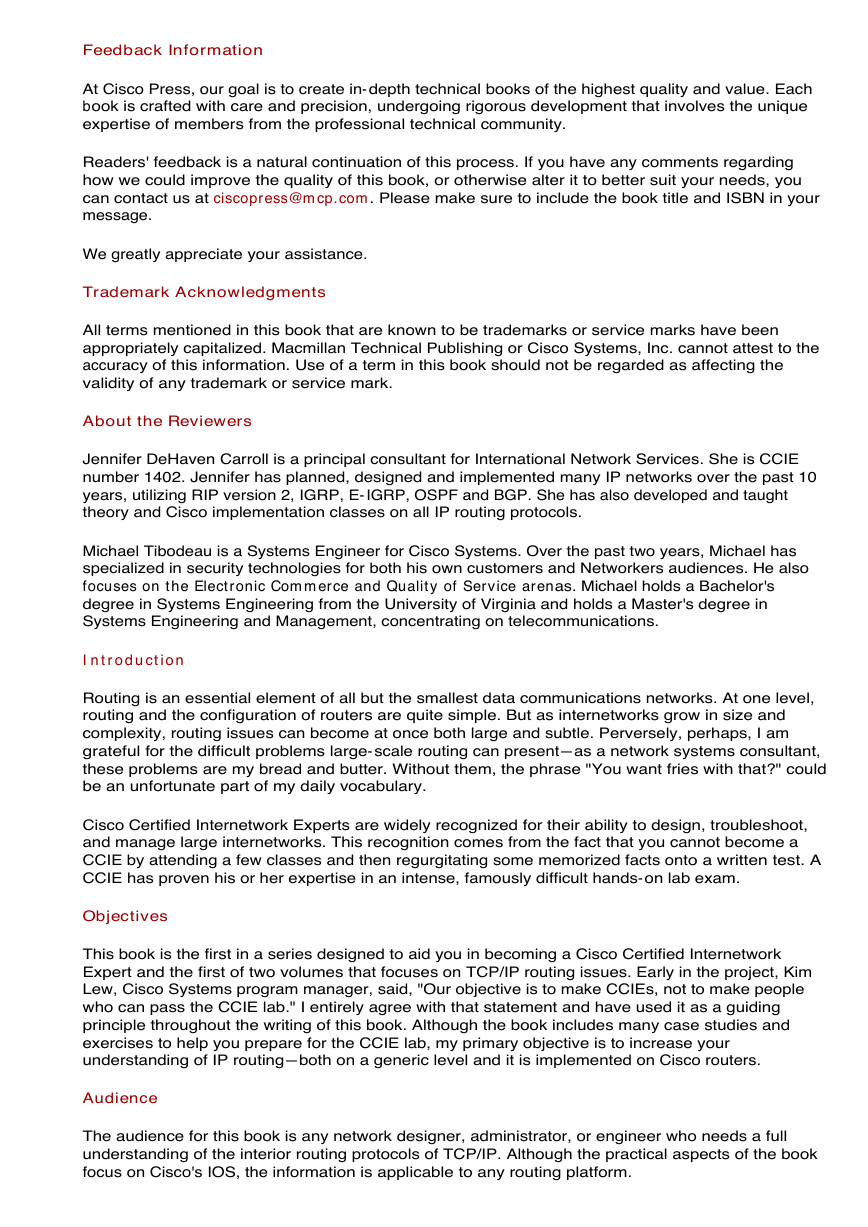
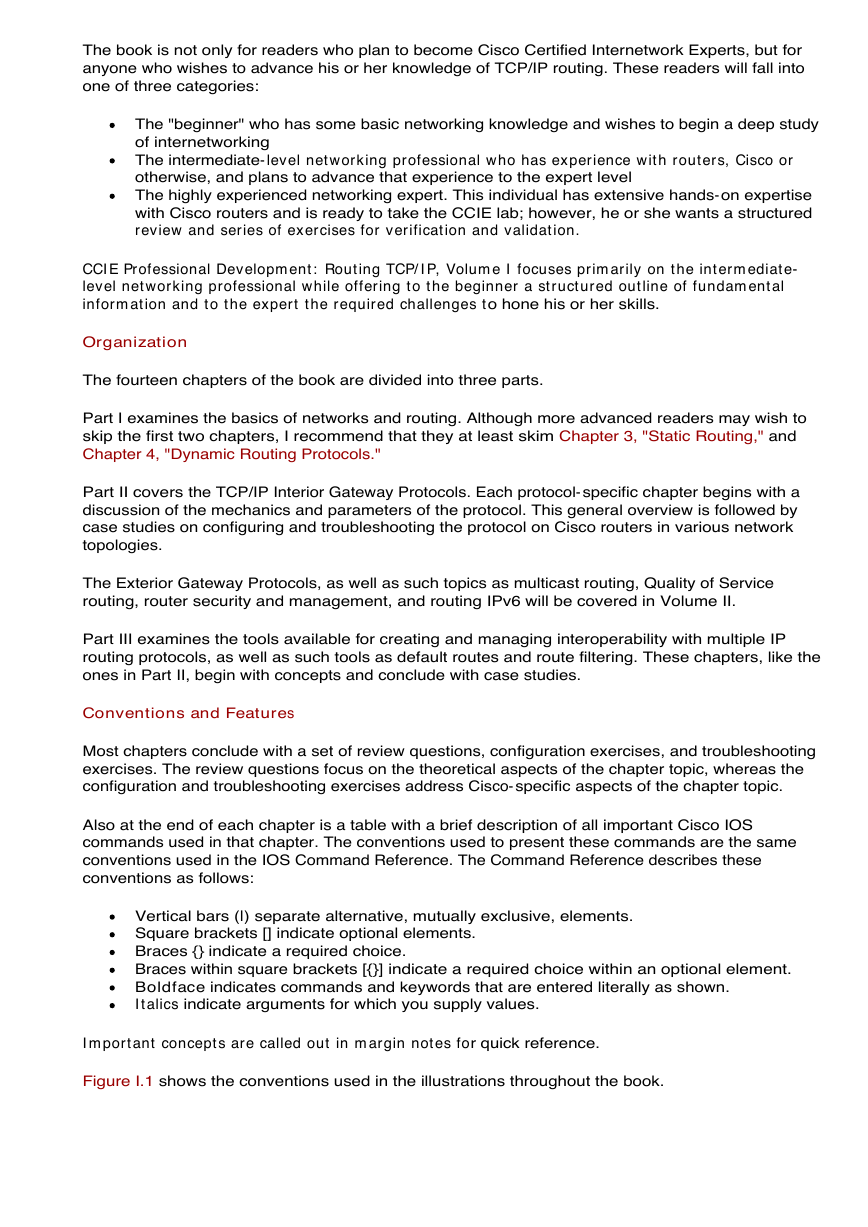
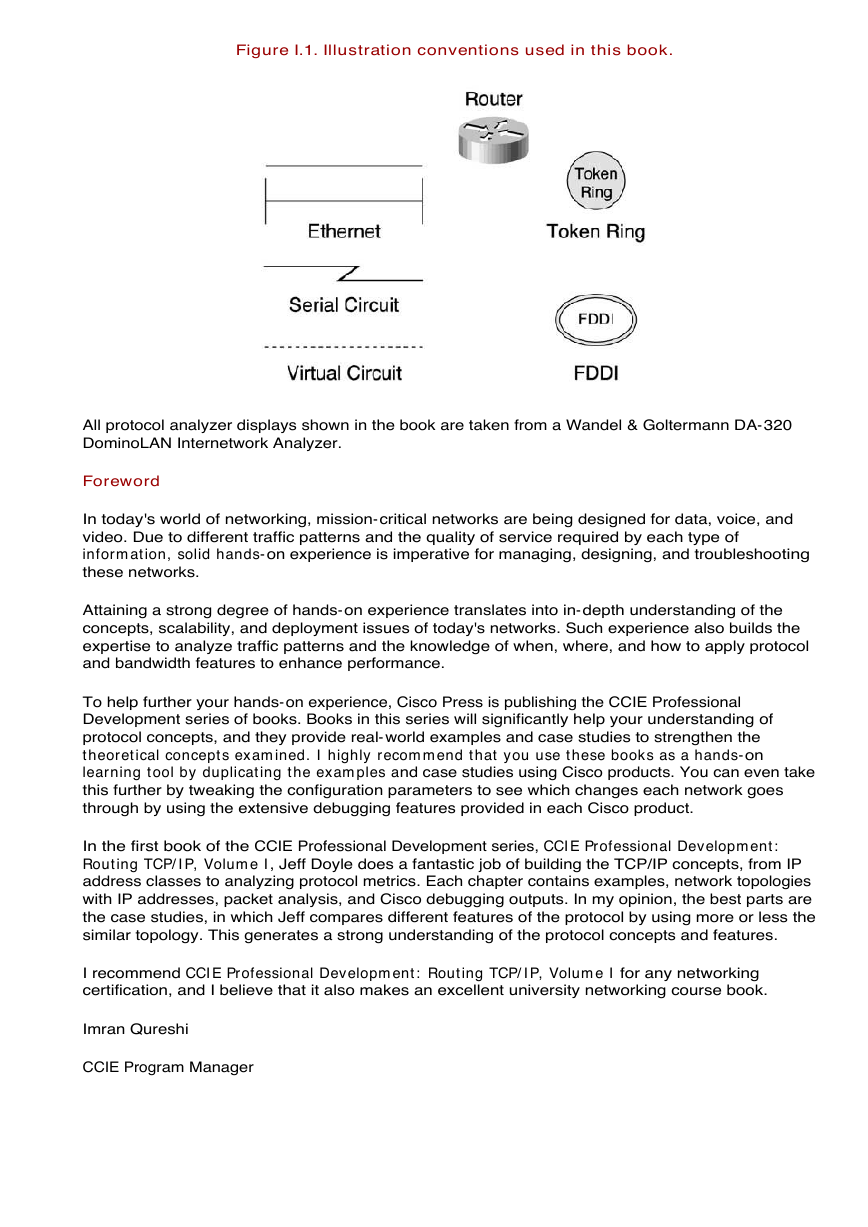
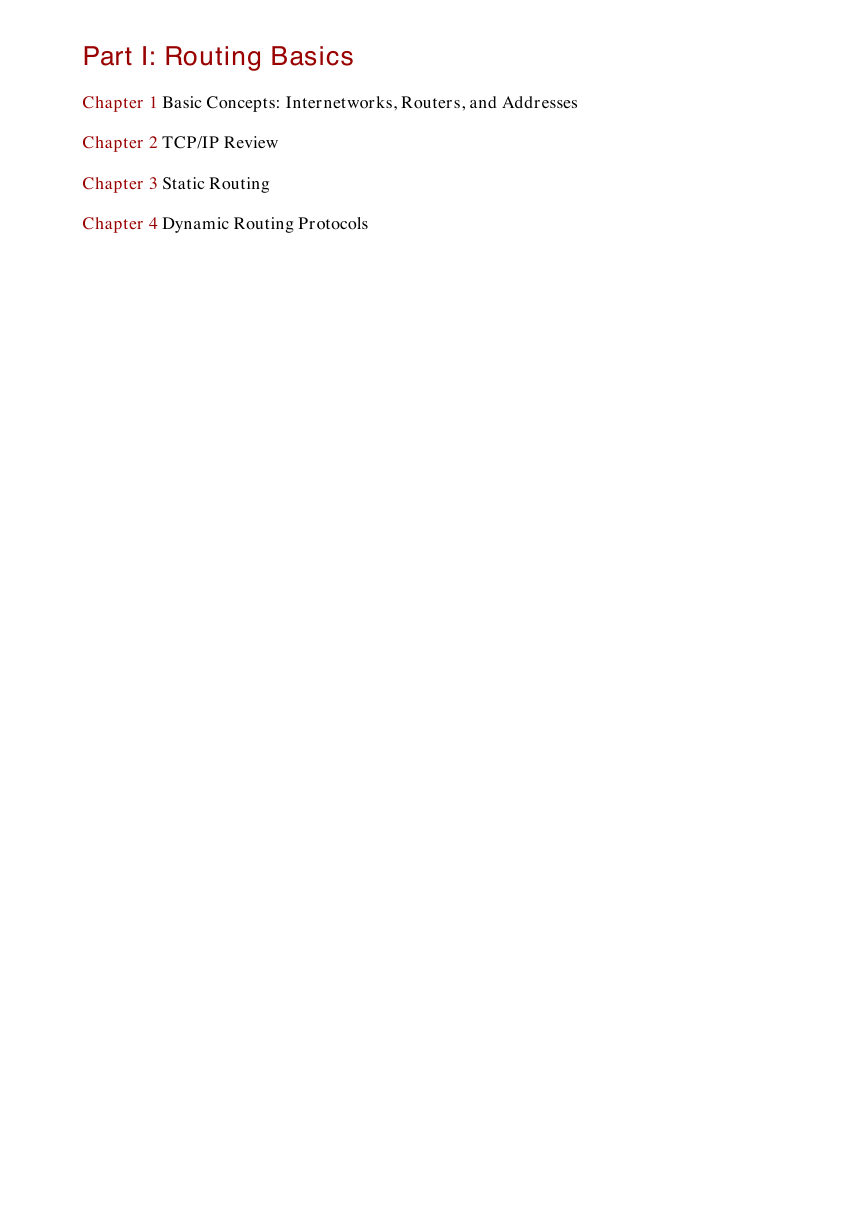
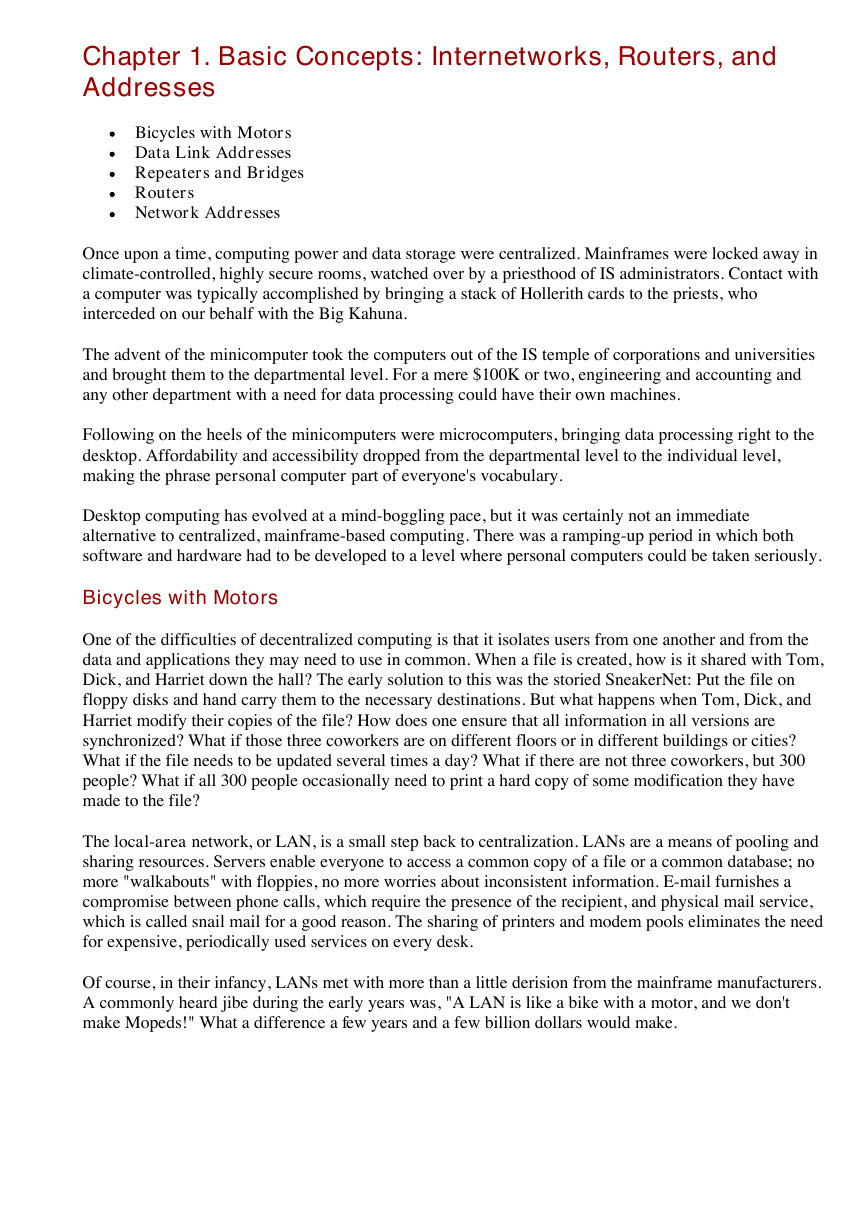
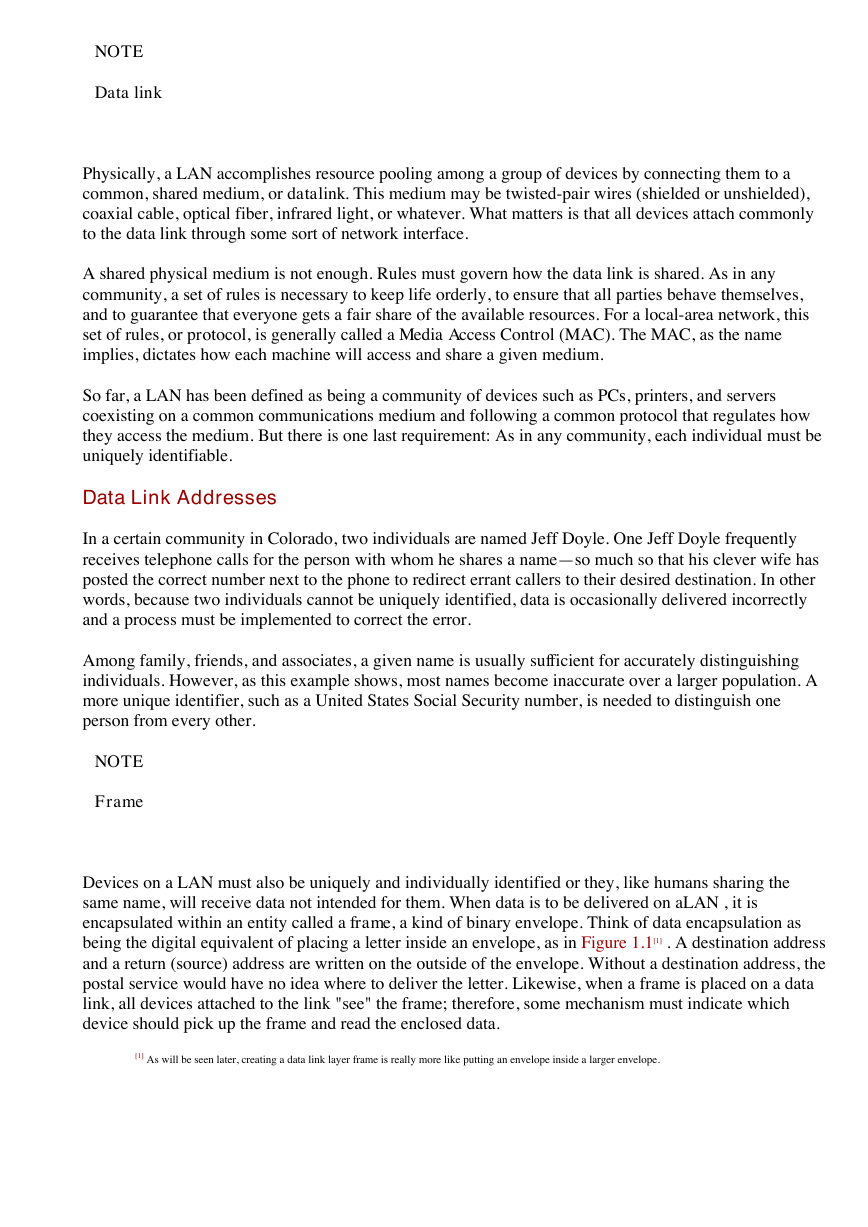








 2023年江西萍乡中考道德与法治真题及答案.doc
2023年江西萍乡中考道德与法治真题及答案.doc 2012年重庆南川中考生物真题及答案.doc
2012年重庆南川中考生物真题及答案.doc 2013年江西师范大学地理学综合及文艺理论基础考研真题.doc
2013年江西师范大学地理学综合及文艺理论基础考研真题.doc 2020年四川甘孜小升初语文真题及答案I卷.doc
2020年四川甘孜小升初语文真题及答案I卷.doc 2020年注册岩土工程师专业基础考试真题及答案.doc
2020年注册岩土工程师专业基础考试真题及答案.doc 2023-2024学年福建省厦门市九年级上学期数学月考试题及答案.doc
2023-2024学年福建省厦门市九年级上学期数学月考试题及答案.doc 2021-2022学年辽宁省沈阳市大东区九年级上学期语文期末试题及答案.doc
2021-2022学年辽宁省沈阳市大东区九年级上学期语文期末试题及答案.doc 2022-2023学年北京东城区初三第一学期物理期末试卷及答案.doc
2022-2023学年北京东城区初三第一学期物理期末试卷及答案.doc 2018上半年江西教师资格初中地理学科知识与教学能力真题及答案.doc
2018上半年江西教师资格初中地理学科知识与教学能力真题及答案.doc 2012年河北国家公务员申论考试真题及答案-省级.doc
2012年河北国家公务员申论考试真题及答案-省级.doc 2020-2021学年江苏省扬州市江都区邵樊片九年级上学期数学第一次质量检测试题及答案.doc
2020-2021学年江苏省扬州市江都区邵樊片九年级上学期数学第一次质量检测试题及答案.doc 2022下半年黑龙江教师资格证中学综合素质真题及答案.doc
2022下半年黑龙江教师资格证中学综合素质真题及答案.doc